Recent Why SERVPRO Posts
Everything You Need To Know About Mold Testing
8/22/2022 (Permalink)
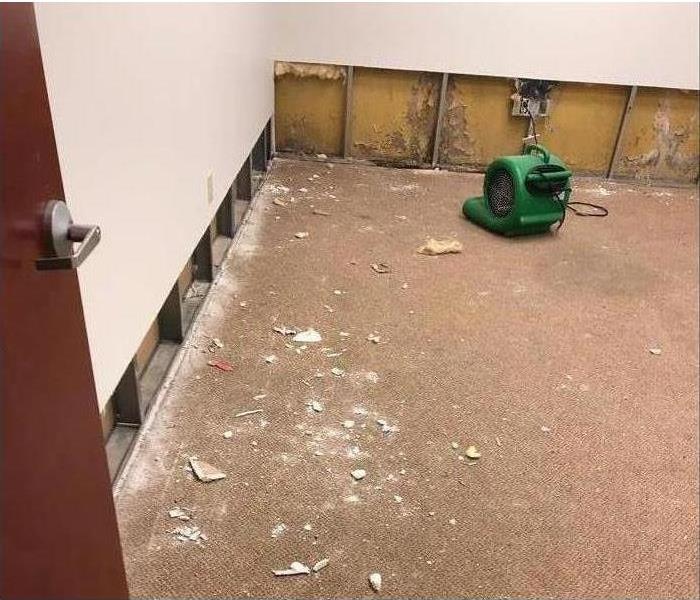 Mold damage in Amberley Village, OH
Mold damage in Amberley Village, OH
As a residential homeowner or renter in Amberley Village, OH, you are constantly cleaning and maintaining your living space. This requires frequent cleaning, occasional maintenance and personal inspections. But what do you do when you suspect mold growth? Many people don't know what to do when this happens, and they may ignore it, which leads to more mold growth and potential structural problems. Here is everything you need to know about mold testing and what the best course of action may be for your situation.
How To Look for Signs of Mold
How do you recognize possible signs of mold? Before you even consider testing for mold, here are a few key signs that there may be mold colonies in your home:
- Warped walls or ceilings
- Discoloration
- Musty smell
- Areas that have water damage
If during your routine inspections and cleaning you find some of these signs, you may be dealing with a mold problem. Keep in mind that mold thrives in wet, humid places.
What Mold Testing Is
There are different kinds of testing, but some are better than others. One of these is a DIY mold inspection called a mold kit. However, the fact of the matter is this: mold is everywhere. Mold spores float through your house all the time, so it's often likely that these mold kits will test positive for mold.
The best type of testing is the kind you get from licensed hygienists. They will visually inspect suspicious areas, check for hidden water damage and sample for mold. This thorough inspection is much more accurate and can lead to a better understanding of what's going on in your house.
If you have any inclination that mold is growing in your house, it may be best to talk to a mold inspection company. They have the expertise needed to understand the mold situation, which can be much more accurate than a DIY mold inspection.
Why Does Mold Grow On Bread?
7/31/2022 (Permalink)
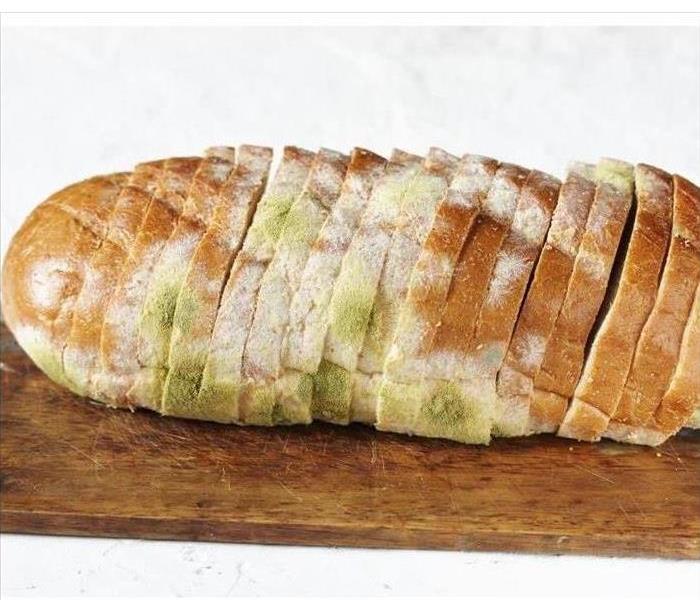 Mold growth on bread
Mold growth on bread
Basic Facts About Mold Growth On Bread
Bread is a food staple in most homes. Unfortunately, bread mold causes a lot of food waste. In order to prevent further waste, understand the basic facts about why mold grows on bread.
1. Bread Is Stored in the Perfect Environment for Mold Growth
Bread is often kept in a warm, moist area. Meanwhile, mold grows best in just such a humid environment, sometimes doubling in less than an hour. When there are mold spores in the air — sometimes numbering in the millions — those spores settle on the bread and multiply. That mold will continue to grow as long as there is a food source.
2. Bread Is a Great Food Source for Mold
Mold is part of the fungi family. Fungi use plants and animals as food sources because they cannot get energy directly from the sun like other plants. Bread is a highly desirable food source for mold. Because of this, bread mold is a very common problem in most households.
3. Make Your Bread Last Longer
Mold can grow in colder temperatures too, including inside a refrigerator. Fridge mold simply grows at a slower pace. You cannot avoid mold growth by storing food in the fridge, you can only delay it. To make bread last as long as possible, only keep a few days' worths of bread handy in the cupboard and freeze the rest until needed.
If you discover moldy bread in your cupboard, it is best to wrap the bread in plastic and dispose of it. It is also a good idea to clean the area where the moldy bread was found and make sure it did not spread to nearby items.
Most bread mold is generally harmless to healthy people; however, poisonous mold does exist. If you find that mold and fungus growth is a persistent problem in many parts of your home in Mariemont, OH, consider calling a mold remediation specialist to identify and address the source of the problem.
4 Steps To Clean Up Your Crawl Space After a Flood
5/18/2022 (Permalink)
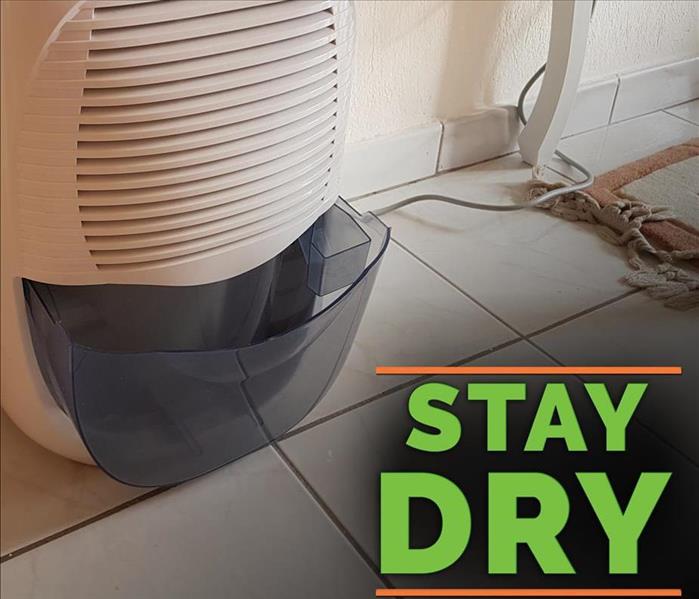 Use a portable dehumidifier to dry out the area.
Use a portable dehumidifier to dry out the area.
Cleaning Up After a Home Flood
The storm has passed, and like many residents of Mariemont, OH, you now face the task of cleaning up after a home flood. One area that tends to get overlooked is the crawl space. Flooding under your home can lead to damage and mold, however, so it's best to address it as soon as possible.
1. Asses the Storm Damage
How much water got in, and how long has it been there? The more water that is present and the longer it has been there, the more damage there is likely to be. For more serious flooding, reach out to a professional restoration company.
2. Remove the Water
The first step is removing the water; a pump or a wet-dry vacuum can accomplish this. You may need to reposition it a few times to get to all of the puddles. Once all of the standing water from the home flood is gone, look for any wet material and remove this as well. This includes wet insulation, rotting wood and anything moldy.
3. Dry the Area
Next, use a portable dehumidifier to dry the wood framing, the floor and the subfloor. Set the humidity level to 40%, and let it run for up to 10 hours, checking it every few hours. You can speed up the drying process by adding a lightbulb or electric fan to provide low heat.
4. Restore the Crawl Space
Once the crawl space is dry, disinfect it by wiping all surfaces down with a bleach solution of 1 cup of bleach to 1-gallon water. This will prevent future mold growth. If you had to remove any damaged wood or insulation, now is the time to replace them.
Now that you are back on a solid foundation with a clean and dry crawl space, look at home flood prevention and storm mitigation for the future to keep your place protected.
Understanding Water Contamination
5/10/2022 (Permalink)
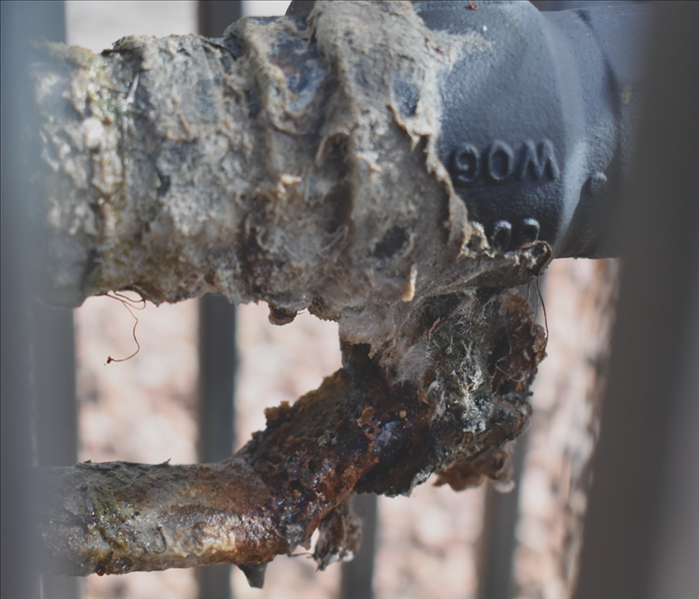 Sewage backup is contaminated with biological viruses and bacteria.
Sewage backup is contaminated with biological viruses and bacteria.
Water Contamination
Water contamination poses a threat to both humans and the environment. Water becomes contaminated when it is altered by the presence of chemicals, microbes, or some other physical change. Even water that enters your house in Madeira, OH, via the main water supply line contains small amounts of contaminants that are harmless.
1. Chemical Contaminated Water
Chemical contaminants are compounds or elements that occur naturally or can be man-made. These include pesticides, salts, bleach, nitrogen, drugs, toxins, and metals.
Your water might be chemically contaminated if it is cloudy or filmy, contains sediment, has a metallic taste, smells of sulfur or chlorine, or shows some coloration.
2. Biological Contaminated Water
Biological contaminants are microbes or microscopic organisms that transmit disease. These can include pathogens such as parasites, bacteria, protozoa, and viruses.
Signs that your drinking water might include any of these pathogens include fatigue, nausea, headaches, fever, cramps, vomiting, or diarrhea.
3. Physical Contaminated Water
Physical contaminants concern the physical properties of water and normally can be seen. Any organic material or sediment buildup in lakes, rivers, and streams, and wastewater from sewage are physical contaminants.
4. Waste Water
Contaminates are present in wastewater, which is water that has been used in the home and water from rain runoff. There are two categories of wastewater in the home.
Black water is wastewater from toilets, typically called sewage. It contains urine and feces, as well as water and toilet paper, from flush toilets, and can carry pathogens.
Gray water is wastewater from bathtubs, showers, sinks, and washing machines. Because it has a lower level of contamination, gray water is easier to treat and process.
If you suspect your water is contaminated, you should immediately stop using it and contact a professional water damage company. Water contamination harms the environment and can lead to disease, illness, and even death.
The Fire Restoration Process
11/22/2021 (Permalink)
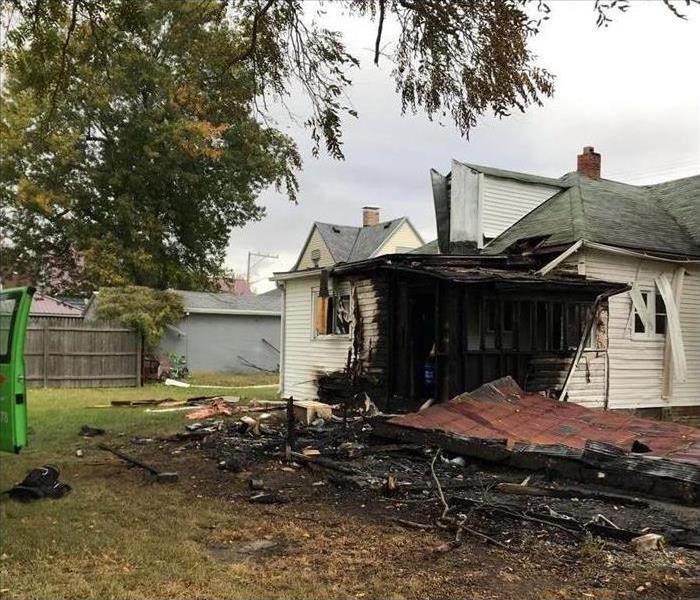 Fire damage in Indian Hill, OH
Fire damage in Indian Hill, OH
4 Steps in Getting Your Home Back to Normal
After a fire in your Indian Hill, OH, home, you may feel overwhelmed by the fire restoration process. Knowing what to expect beforehand can make the situation less stressful for you and your family. Every fire and home are different, and the restoration process varies accordingly. Here are four general steps that occupants take in getting their home back to normal after a fire:
1. Inspection
Surveying the damage after a fire is critical to knowing the next steps that you need to take. However, this can be dangerous if you are not careful. Do not re-enter your home until the fire department has said it is safe to do so. Do not turn on any appliances or lights that were near the fire.
2. Preventing Further Damage
Preventing further damage is key to the fire restoration process. This includes boarding up or tarping over any openings in the structure to prevent wildlife, criminals, etc. from getting inside. Additionally, it is important to remove any water left over from the fire extinguishing efforts because mold growth begins quickly. After the water has been removed, smoke damage should be addressed. Smoke and soot are corrosive. The longer they are allowed to sit, the more damage they cause.
3. Cleaning
After taking precautions to prevent further damage, clean-up efforts can begin. Damage cleaning takes many forms and may occur on-site or at another location. In addition to cleaning the surfaces of your home and the items within it, it may be necessary to address any lingering smoke odor. From air scrubbers to ozone machines, there are a variety of methods to remove smoke particles from the air in your home.
4. Repair and Restoration
After the smoke (and soot and water) clears, it is time to repair the damage caused by the fire. You may have to repair drywall, replace carpeting and windows, or even fully reconstruct parts of your home to get it back to normal.
Regardless of the extent of damage done, an experienced restoration service can help you with every step of the fire restoration process.
What Can an Environmental Hygienist Do That a Mold Test Can't?
10/25/2021 (Permalink)
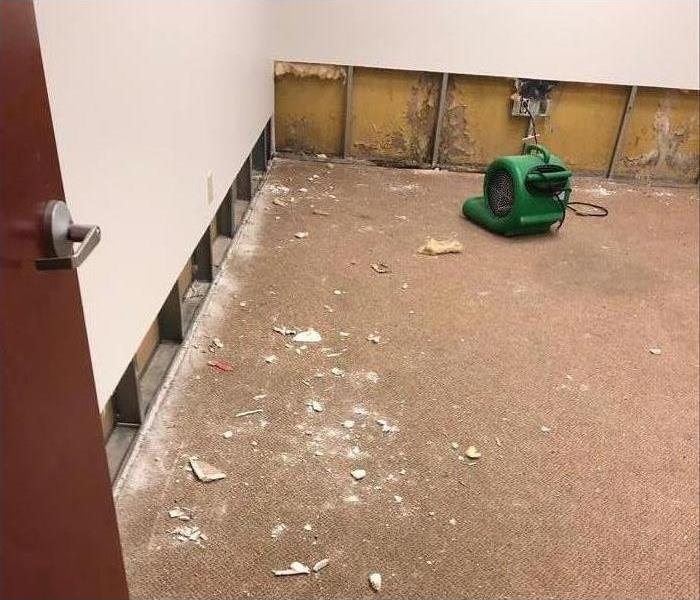 If you found mold growth in your home you need to work with a certified professional.
If you found mold growth in your home you need to work with a certified professional.
What Does an Environmental Hygienist Do That a Mold Test Doesn't?
You have a hunch there's mold growth in your home in Madeira, OH. You know you can call in a residential mold cleaning professional, but you're not sure this is the right option for you. After all, you can perform a DIY mold test on your own for significantly less money. The test will help you figure out if there's mold in your home and if you need a professional's help, right? The fact is you may need help to determine if there is fungus growth in your home.
• Maintain reliability. You are the one who has to do a home mold test. This means you have to ensure the samples are handled correctly and contamination is avoided. A hygienist's training helps ensure the results of the test are reliable.
• Locate growth. Mold damage can be hard to find. There are a lot of hidden areas in your home that could allow mold growth. A professional can not only help you figure out if fungus is present in your home but also determine where it could be.
• Explain the results. When you trust a DIY test, you have to decipher the results on your own. A professional, on the other hand, can explain how some of the mold found is harmless spores that always occur in the air.
• Create a plan. If the test shows there are problematic levels of mold in your home, an environmental hygienist can help you create a mold cleaning plan. This may help you get rid of the growth before it is able to spread to other parts of your house.
• Refer cleaning help. A hygienist may also help you find a reliable mold remediation team if you don't already have one. Finding experts who can remediate the problem is essential.
Home mold tests may be cheaper, but they don't offer the same level of insight as an environmental hygienist does. When you want to know if you need to start a mold cleaning process, you need to work with a certified professional.
To Test or Not To Test: Detecting Mold in Your Home
9/13/2021 (Permalink)
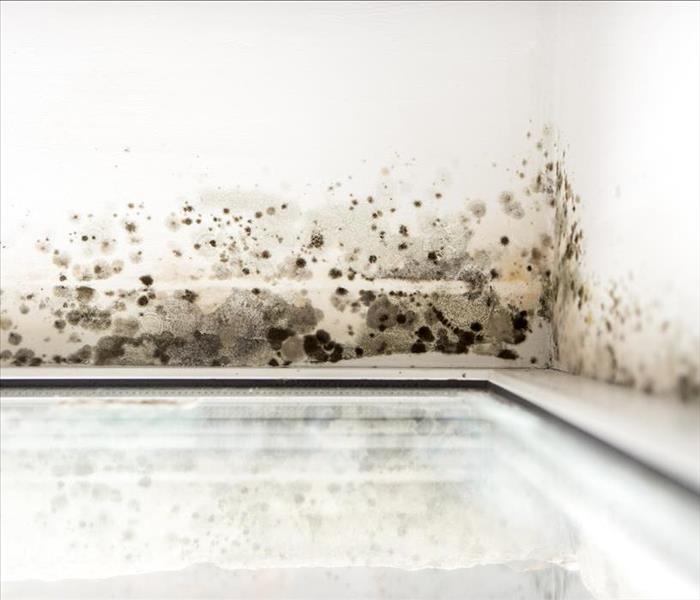 If you suspect that there is a mold problem in your home, you are better off having a CIH conduct the mold testing rather than do it yourself.
If you suspect that there is a mold problem in your home, you are better off having a CIH conduct the mold testing rather than do it yourself.
As a homeowner, you probably take great pride in being able to care for your home yourself. You generally have the knowledge and the skill to keep it clean and safe for your family. Certain problems, however, such as mold growth, may require professional help. You need a certified industrial hygienist to conduct the mold testing and, if a mold problem is found, a mold remediation specialist to take care of it.
Inspection Techniques
When the CIH arrives at your home in Cincinnati, OH, he or she will go through the process of analyzing the air quality in your home. The CIH will perform three main techniques:
• Conduct a visual inspection
• Measure moisture in the air
• Compare baseline outdoor air samples to indoor air samples
Two results of mold testing can be indicative of a problem. First, if the mold spores of a particular species are more highly concentrated in the indoor air than in the outdoor air, they are probably feeding off something and thus multiplying at a more rapid rate than usual. Second, if there is a species of mold found inside that is not found outside, this, too, can indicate a problem.
DIY Techniques
Many home improvement stores sell kits so that their customers can conduct DIY mold testing in their homes. More often than not, however, a mold kit is a waste of money. The kit simply tests for the presence of mold. Without fail, the results are going to be positive. Mold is everywhere. Without first establishing a baseline test of mold concentration found outdoors, no indoor test is going to tell you anything useful.
If you suspect that there is a mold problem in your home, you are better off having a CIH conduct the mold testing rather than trying to do it yourself. The professional will get more accurate results which leads to your problem getting resolved more quickly.
3 Simple Tips To Stay On Top Of Mold in Your Home
8/10/2021 (Permalink)
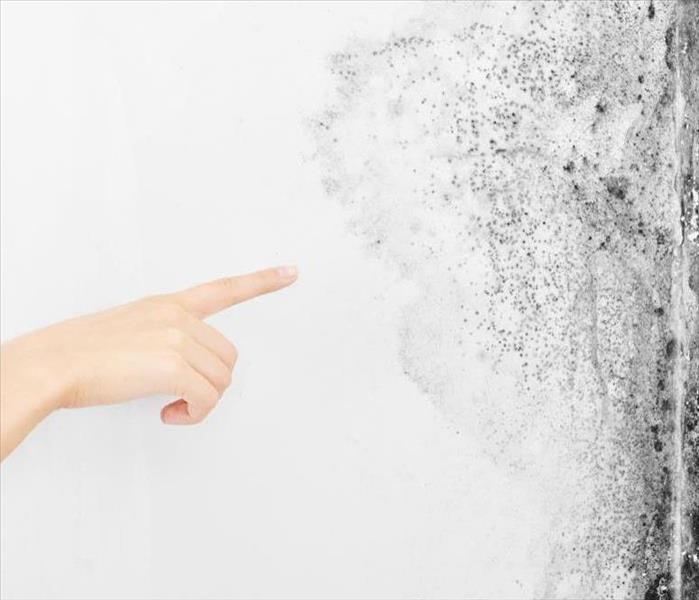 Call SERVPRO in Indian Hill, OH, we can help you to deal with the mold at home.
Call SERVPRO in Indian Hill, OH, we can help you to deal with the mold at home.
3 Easy Ways to Keep Mold Out of Your House
You may not know it, but your home probably has mold in some form or another. This can be the result of water damage or not. Mold grows easily in Indian Hill, OH, and throughout every other climate in the world. Although mold may be growing in areas of your home that you can’t see, you may be able to control it. There are a few different ways to do that, including the following.
1. Keep Commonly Wet Areas Dry
It’s often a good idea to keep dry those areas that frequently get wet. Always keep a towel on hand in the bathroom to sop up any wet spots after a shower or bath. If part of your house has had water damage, it is generally a good idea to be hyper aware of these areas to make sure they stay dry.
2. Have Proper Ventilation Throughout Your Home
In most cities, it is legally required for homes to have ventilation in every bathroom, either through a vent or a window. This is primarily required to prevent mold growth. However, you should have ventilation anywhere that may get wet, such as in the attic space and basement, which tend to collect moisture or get more humid than the rest of the home.
3. Divert Water Away From the House
Take a look outside your home. Take note of where the water goes when it rains. Does your landscaping slope toward your house? How about the rain gutter? For optimal mold prevention, make sure that the water it collects isn’t so close to your home that the foundation is likely to get and stay wet the next time it rains.
Although there is no such thing as a completely mold-proof house, it is possible to curb the spread of mold spores and control it as much as you can. Calling a restoration specialist can help, but in between treatments, follow these simple tips and tricks for mold prevention following water damage as well as during your daily routine.
Q2 2021 Franchise Teammate One Team MVP Finalist Dylan Riddle
6/11/2021 (Permalink)
 We are more than proud to have Dylan as a part of our SERVPRO family.
We are more than proud to have Dylan as a part of our SERVPRO family.
Dylan Riddle has been the job file coordinator with SERVPRO of East Central Cincinnati and West Hamilton/Oxford for more than three years. There he has taken his work ethic, knowledge, and positive attitude to help improve his franchise's job cycle times and audit scores. While he rarely works in the field, customers often compliment the customer service when working with Dylan. His help was even on display during the recent Winter Storm in Texas and Oklahoma as he provided help managing the influx of work during the event.
Dylan has been absolutely critical in the turnaround of our franchise. Approx. three years ago we realized we were one of the worst franchises in regard to upload scores and job cycle times. After spending the majority of the year in a "red light" status, we had to take action to correct these deficiencies. We made a significant amount of internal changes, however, we still struggled with our audit scores. Despite our efforts, we could not seem to grasp the process. Fortunately, Dylan came along and was able to quickly help us turn things around and surpass the very lofty goals I had set.
In June of 2019, he informed me we had reduced our office cycle time from 8+ days to 1.5 days, which surpassed our previously set goal of 2 days, all while raising our average audit score into the 90% range. On that same phone call, I had informed Dylan that our new goal was to get our office cycle times down to a point where it started with a decimal point (example .75 days). Without reservation he accepted this challenge and simply replied with, "yes sir, I will have some ideas emailed to you by tomorrow morning with some ways we can make it happen." He followed through with his commitment, and for 2020 our current office cycle times are .12 days with a 100% job audit score. I could honestly go on and on and name scenario after scenario where Dylan has met/exceeded established goals time after time. Dylan is a true team player and I could not think of anyone more deserving of the MVP award.
Do the right thing: Dylan seems to be intolerant of shortcuts or anything short of his best effort. It is reflected in his audit scores, as well as the positive feedback we receive from customers on a regular basis, which is impressive considering he rarely steps foot on many of our mitigation projects.
Serve others: I have personally made some pretty insane requests at all hours and I have never heard any hesitation on his behalf. He is a true team player who is all about providing the best experience for the customer and taking actions to improve those around him.
Stay positive: Anyone who spends five minutes on the phone with Dylan would immediately identify how incredibly positive he is. When Dylan first started with us, I reviewed all of his job files to ensure they were to our franchise's new standard. This is something we do with all employees, and usually after a week, each requested revision is usually met with some form of hesitation/frustration. However, I never experienced that with Dylan. This is very atypical, so when I asked him about it he responded with, "Boss I figured you were just trying to push me out of my comfort zone, so I have just turned it into a game to see if I can write an Xactimate where you can't find anything to add, and if I can't do that, I will at least make you work really hard to find something."
Hustle/Grind: Since Dylan is part of the administrative team, he is not expected to regularly perform his duties after hours or on the weekends, but that has not stopped him from working countless hours outside of his "normal hours." When we really started gaining traction and seeing the fruits of our focus on cycle times, we challenged Dylan to get our office time down to a metric that started with a decimal point, and that the goal was to get the number so low that when people read our numbers, they were equal parts confused and suspicious. Dylan took that request to heart, and to this day, if the production staff pulls equipment on a Saturday, he is in the office placing the finishing touches on the job file and submitting for billing.
Collaborate: Dylan is a true believer of the ONE TEAM mentality and has helped or provided pointers to quite a few other franchises. During the most recent freeze event in Texas and Oklahoma, Dylan became a resource for Storm Team Wilson during the weekly admin webinars. He noticed the high volume of questions that seemed to be heading towards the unmanageable levels and quickly jumped to action and started fielding questions so that the members of Storm Team Wilson could address the more complex or dynamic questions.
– Brandon Johnson, general manager, SERVPRO of East Central Cincinnati
Pretesting, Innovative Tools Help Salvage More Damaged Property, Belongings
2/25/2021 (Permalink)
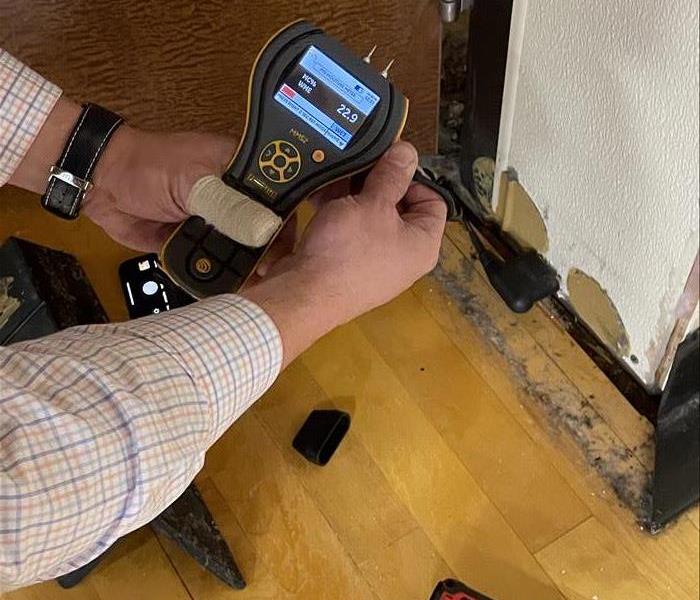 Moisture detection in a Madeira, OH commercial property.
Moisture detection in a Madeira, OH commercial property.
Pretesting, Innovative Tools Help Salvage More Damaged Property, Belongings
If your commercial property in Madeira, OH, sustains a water loss, the initial scene can be overwhelming. While it may seem like little is salvageable and your insurance claim will be over the top, a certified mold and water damage and restoration company will have the tools and expertise to perform pretesting and make a restoration plan to minimize claims and get your property back to “Like it never even happened.”
Inspection
Even though you may already have damage, a key to minimizing costs is ensuring it doesn’t spread. After calling a professional, they will quickly respond to start the saving process.
Within four hours, a technician will arrive on-site to assess the damage and develop a mitigation plan.
The professional will clearly explain the assessment and plan, ensuring you have a clear understanding of the process.
After the on-site visit, the professional will communicate the scope of the project with your insurance agent or claims adjuster.
Pretesting will be done to determine if items can be restored.
Restoration
Once the cleanup and restoration process begins, certified professionals have an arsenal of tools and techniques to clean, repair and restore the structure and many of the items within it. These include:
Moisture Detection: This is used to measure and monitor moisture levels, including detecting hidden water.
Water Extraction: To speed up the drying process, portable or truck-mounted extraction equipment will be used to pump out high levels of water.
Drying: Industrial-strength humidifiers and air mover are used to eradicate leftover moisture from throughout the structure.
Cleaning and Deodorizing: Salvageable belongings will be removed and taken to a secure location to clean and remove odors. Different methods will be used depending on the item, such as dry, immersive, or wet cleaning. Air scrubbers, thermal foggers and anti-microbial treatments are used in the property to eliminate odors and sanitize.
A water loss may seem like a difficult situation to get out of, but taking quick action and pretesting damaged items ensures more can be restored instead of replaced.
Why You Should Add a Mold Endorsement to Your Pollution Liability Coverage
12/14/2020 (Permalink)
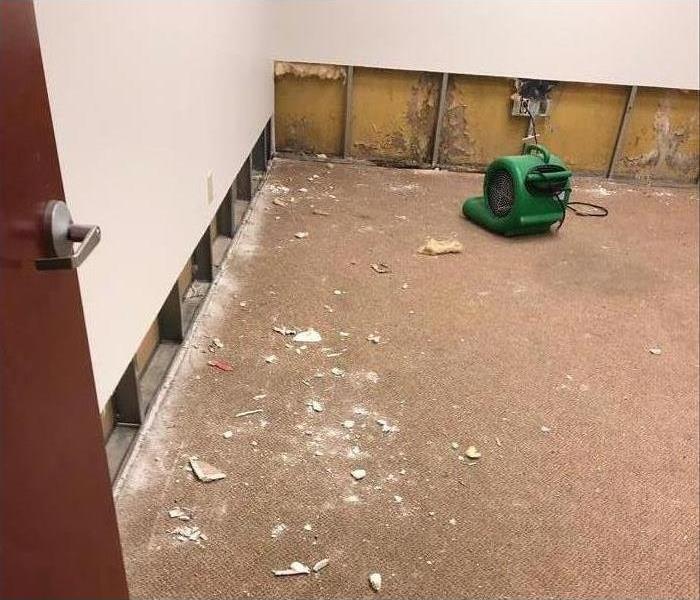 Mold damage in Cincinnati, OH
Mold damage in Cincinnati, OH
Mold is a nightmare for any property owner in Cincinnati, OH. A small infestation can quickly become a larger problem that necessitates mold remediation services. This could affect both your finances and your local reputation.
To mitigate the harm to your property and business, you need to address any mold damage as soon as possible. Mold insurance claims can help you pay for the cost of restoration. To ensure that your insurer covers mold cleanup, you should purchase an endorsement to your regular pollution liability policy.
How To Get a Mold Endorsement
Your pollution coverage helps pay for claims resulting from pollutants released by your property or a piece of equipment. You can purchase optional add-ons to this policy, as well. These enhancements could cover:
- Illicit abandonment
- Fungi
- Legionella
- Mold
The mold endorsement, in particular, could save you money on fungus cleanup in the future. Simply contact your pollution insurance provider to find out more information.
Why You Need a Mold Endorsement
You may think that you can just use your general liability policy to make mold insurance claims. Unfortunately, it is not that simple. Not all property policies include mold coverage.
Even if you can make a mold claim with your general liability provider, the payout is likely limited. The money you receive will not be enough to pay for proper remediation and investigation. You may be forced to do the repairs yourself or hire a cheap contractor. Choosing either of these options may just spread the mold further.
To truly remove the mold and prevent it from returning, you need top cleanup professionals. A mold endorsement should give you the money you need to pay for this service.
Not every general liability policy lets you make mold insurance claims. You thus need to add a mold endorsement to your pollution coverage. This way, if you do have a mold infestation in your building, you can afford to hire qualified professionals to eliminate the problem.
5 Common Types of Household Mold
11/30/2020 (Permalink)
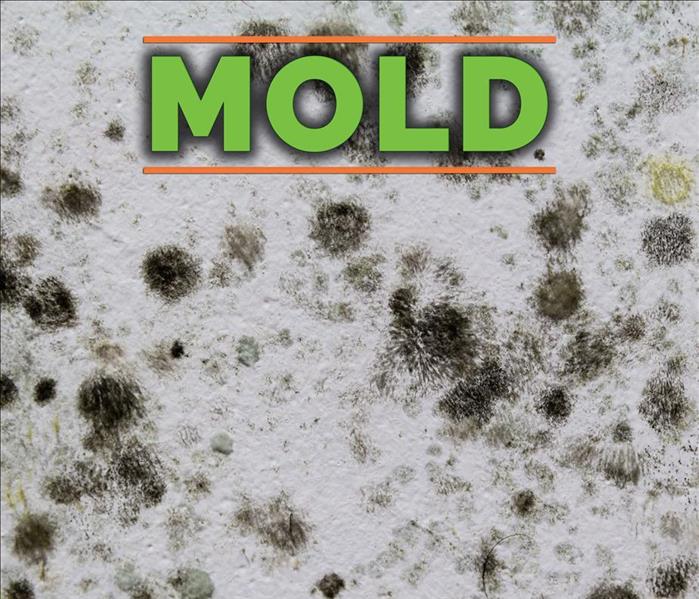 Stachybotrys is perhaps the most common type of residential mold
Stachybotrys is perhaps the most common type of residential mold
Know Which Common Varieties To Look For
It's not uncommon to discover mold growing in your Indian Hill, OH, home. Mold growth can occur under several different circumstances, depending on the type of fungi in question. Before you begin your mold remediation process, you should identify which species is the culprit.
1. Stachybotrys
More commonly referred to as the infamous black mold, Stachybotrys is perhaps the most common type of residential mold. Much like the name implies, it has a dark green or black color and may feel slimy to the touch. It's very common in places that come into frequent contact with water, or in areas that have recently suffered some form of water damage.
2. Alternaria
This species of mold is often confused for black mold, as it thrives under the same damp or high humidity conditions, has a very similar appearance and is just about as common as its cousin. Instead of feeling slimy, alternaria has an almost velvety texture due to the wispy dark green or brown hairs that sprout on its surface.
3. Chaetomium
Once again, this type of mold growth is quite common in water-damaged structures. When it first appears, it boasts a white or gray color before slowly fading to dark brown or black over time. You're more likely to smell this species before you see it, due to its musty odor.
4. Aureobasidium
You should check for this type of fungus behind your wallpaper or on painted wooden surfaces. This mold appears pink or brown in color when it's young and slowly fades to black over time, much like chaetomium.
5. Cladosporium
This versatile species of mold can thrive in both warm and cold environments. You're most likely to find it growing in your carpeting, upholstery, and other types of fabrics. It boasts a soft, suede-like texture and green coloring.
You could potentially find several different mold species growing in your home, so it's important that you know which common varieties to look for. Contact mold remediation experts for assistance if you do discover mold growth in your home.
What To Know About Mold and Mildew
9/28/2020 (Permalink)
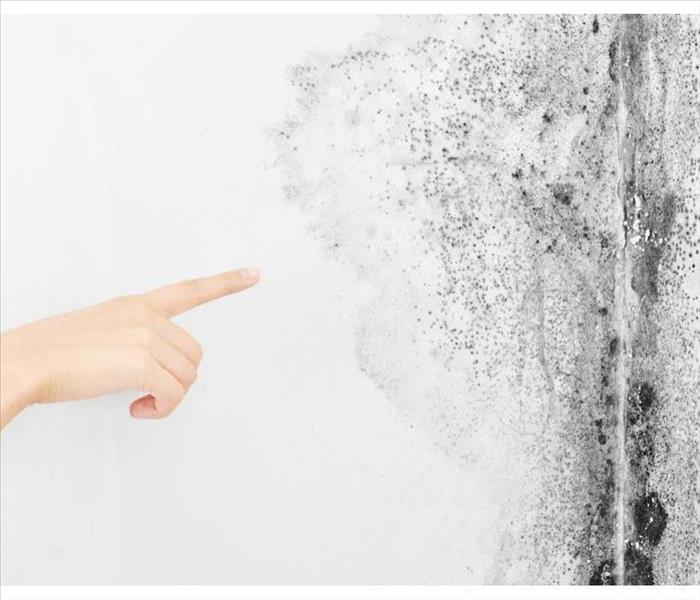 Is it mold or mildew?
Is it mold or mildew?
Is It Mold or Mildew?
When facing mold damage in your Madeira, OH, there are a few things you may want to know. Is it mild or mildew? What kind of damage can it do? And can a mold remediation service help? Here are a few things you may want to know.
1. Both Mold and Mildew Are Fungi
Mold and mildew are both fungi. That is microscopic organisms that form colonies which can then be seen by the naked eye. They grow in dim, damp environments, and feed off organic materials around them. Fungi reproduce by sporing, and during this process can release mycotoxins which are responsible for the musty odor many people associate with them.
2. Mold Can Cause Long Term Damage
Mold growth may be more concerning to a homeowner since mold damage can lead to long term damage from the home. Mold usually grows into the surface the spores have settled on meaning that remediation may involve removal of the surface entirely. Fortunately, a remediation service can help with this process. Mold has a range of colors from white, grey, black, green, and brown, and may be both fuzzy or slimy in appearance depending on its type and location.
3. Mildew is More Common
It should be noted that mildew growth is more common that mold. This fungi grows on the surface in damp environments and should be easily wiped away with a cleaner. It is often, white, yellow, or orange, in coloration, and may be flat and powdery in appearance. Mildew is usually found in areas of frequent moisture such as bathrooms.
Understanding that both mold and mildew are fungi can help you take the appropriate steps to prevent their growth. Remember, while mildew is more common, mold damage can lead to long term problems. This is why it’s important to contact a local remediation service as soon as you believe a problem may exist.
How Ice Dams Can Lead to Mold in Your Building
8/14/2020 (Permalink)
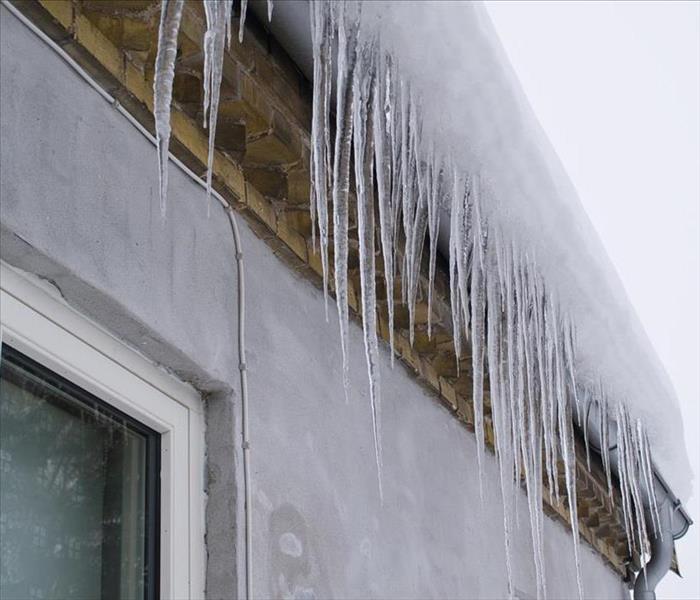 An ice dam can cause moisture from the roof to leak back into your building
An ice dam can cause moisture from the roof to leak back into your building
How Ice Dams Can Lead to Mold in Your Building
Snowstorms and cold weather bring various hazards to your Deer Park, OH, commercial property. You do not just have to worry about burst pipes or floods. An ice dam could also develop on your roof.
Snow will build up on top of your building after a storm. If that snow is above the heated part of your property, it will start to melt. As this water trickles down the roof, it may reach an uninsulated area. It will then freeze into ice that blocks additional water from flowing off the roof. Since this water has nowhere else to go, it will start to leak into your property. This will create wet:
- Wall studs
- Sheetrock
- Insulation
The added moisture subsequently makes the area behind your walls a breeding ground for black mold. If you notice an ice dam on your roof, you should remove it promptly.
Eliminating Ice Dams
There are several ways to get rid of ice dams without having to climb onto the roof. Try using a long rake to break up the pile of ice. You can also create a channel in the dam that allows the water to flow into the gutters. All you need is pantyhose that have been filled with an ice melter.
Preventing Ice Dams
There are also steps you can take to prevent ice dams from forming in the first place. Consider adding insulation to the top level of your building. This should reduce the chances of water on the roof freezing. Adjusting the bathroom and kitchen ducts so that they lead outside the property should help, as well.
An ice dam can cause moisture from the roof to leak back into your building. If this moisture is left unaddressed, it could promote mold growth within your walls or insulation. You should try to remove ice dams on your property as soon as possible. You can then call mold cleanup and remediation specialists to make sure any spores have been eliminated.
Learn About the Commercial Fire Restoration Process
6/8/2020 (Permalink)
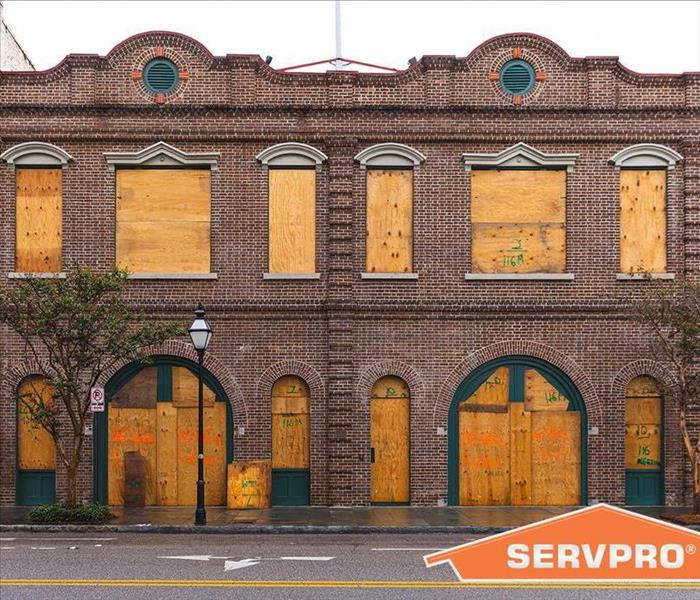 Commercial restoration specialists board-up holes in windows, doors, and walls, as well as spaces where they are absent
Commercial restoration specialists board-up holes in windows, doors, and walls, as well as spaces where they are absent
Learn About the Commercial Fire Restoration Process
Restoration companies like SERVPRO are Here to Help your clients when disaster strikes in their Indian Hill, OH, commercial locations. Besides storm, water, and mold repair, they also offer fire restoration for any damaged business in the area. Once an emergency call has been made and the affected property has been inspected, the rebuilding services begin.
1. Building Board-Up and Roof-Tarp
It is important to stop the progression of damage, as well as potential vandalism of the vulnerable building. Commercial restoration specialists board-up holes in windows, doors, and walls, as well as spaces where they are absent. They also apply tarps on broken or missing roof sections.
2. Smoke, Soot and Water Removal
After the board-up, technicians remove hazardous residues such as smoke and soot before continuing. The use of special equipment and methods to remove the material from all surfaces. If water damage caused by fire sprinklers is present during a fire restoration case, then the water is removed first by using dehumidifiers and ventilation tactics to dry the area.
3. Cleaning and Sanitizing
The fire and potential water damage will leave behind filth, bacteria, and other elements harmful to your clients, their staff and their customers. The employees will clean and sanitize any salvageable items, as well as damaged structures and locations. They will also use products like industrial air scrubbers to remove the strong odors.
4. Building Restoration
The restoration, sometimes known as the fire rebuild, is the most important step of the process. During this part, the professionals engage in full reconstruction of entire rooms, offices, and other key places. Additionally, there are also minor repairs in areas with less damage, such as replacing carpet, painting over discolored sections, or changing the drywall. The goal is to replicate your clients' pre-fire business as closely as possible.
Fire is a very destructive force to commercial locations, but with the right assistance, it is not the end. The fire restoration process, when handled by experienced and licensed experts, can help the establishments you work with return to business quickly and efficiently.
Is Mold Lurking in Your Restaurant Kitchen?
5/6/2020 (Permalink)
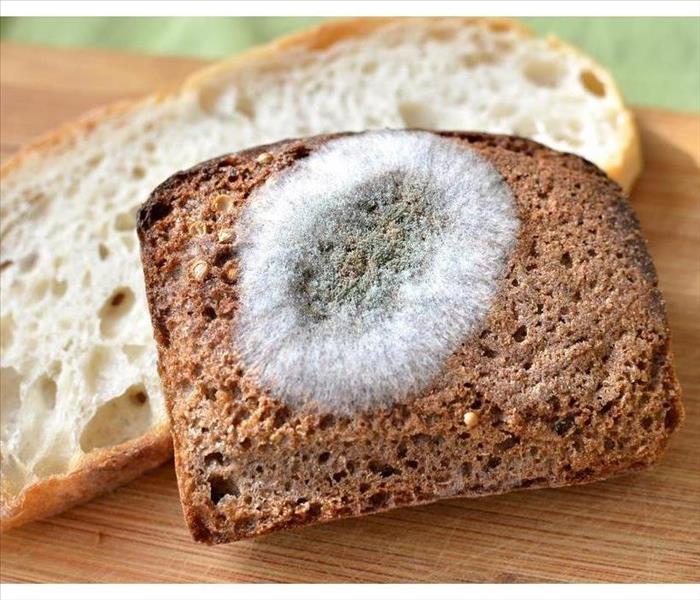 Moldy food should be discarded immediately to prevent cross-contamination
Moldy food should be discarded immediately to prevent cross-contamination
Is Mold Lurking in Your Restaurant Kitchen?
Retaining high humidity in an industrial kitchen is like putting the welcome mat out for mold spores. Mold can go unnoticed for a long time; only mold’s musty odor gives its location away after it has already taken over an area. The trick is to prevent the mold in the first place. Since its main requirement is moisture, you can stifle mold growth by controlling the kitchen’s humidity. Be mindful of:
1. Hidden Areas
Floors and baseboards behind appliances can grow mold due to moisture buildup that goes unnoticed for a while. Floor mats can contribute to the growth of mold from the buildup of moisture and dirt in and under the mat. Kitchens can get steamy; moisture is everywhere at times. This can get into damaged or improperly waterproofed tiles, and air conditioning ducts are also vulnerable.
2. Food
Moldy food should be discarded immediately to prevent cross-contamination. All areas and containers in which food is stored should be checked and disinfected regularly.
3. Ventilation System
Due to all the sources of moisture in an industrial kitchen, it’s crucial to have proper ventilation. The ventilation system should be inspected regularly to prevent the production of excess moisture and the spread of air contaminants. Without proper ventilation, moisture accumulates and can remain virtually anywhere, causing mold growth, and sometimes even water damage.
4. Humidity Level
According to the Environmental Protection Agency (EPA), indoor humidity levels should be no more than 50%, preferably around 40% to lessen the likelihood of mold.
5. Appliances and Plumbing
Restaurant kitchens have many moisture-prone areas you may not even think to inspect. Regularly check around refrigeration units and freezers for standing water and condensation. Also check in vents, under sinks, around microwaves, and in pantries.
6. Constantly-Wet Areas
Dry wet surfaces as soon as possible. Get leaks resolved quickly, and thoroughly wring out wet rags and sponges.
Are you worried that mold growth is lurking in your Terrace Park, OH, restaurant? You can count on mold cleanup professionals to remedy the situation as quickly as possible.
3 Questions You Might Have About Mildew
3/23/2020 (Permalink)
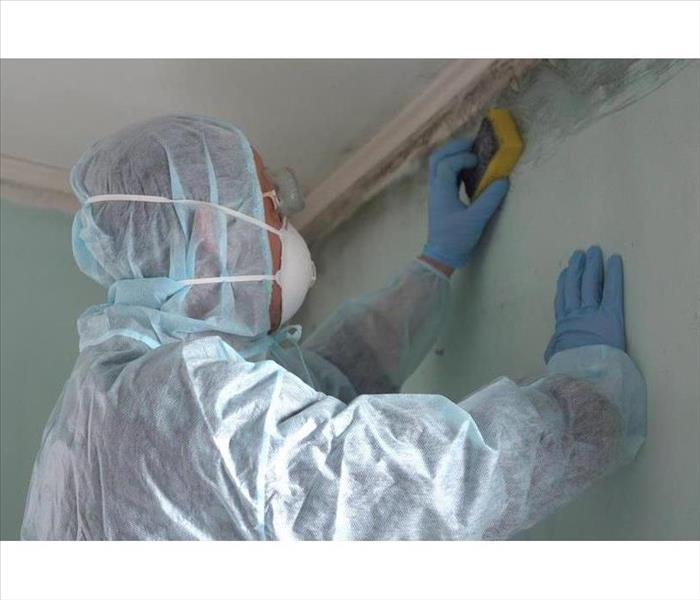 Removing mildew and mold from a property in Indian Hill, OH
Removing mildew and mold from a property in Indian Hill, OH
Fungi spores are everywhere and can grow and develop by feeding on available materials. As you report mold growth resulting from a water-based incident or high humidity to a water damage remediation company, you might think about plant mildew as well. While people often mention these organisms together, they are not interchangeable. If you are unaware of mildew, you might have the following questions about it.
What Is Mildew?
Mildew is a specific type of mold that is also known as an obligate biotrophic pathogen. This term means that it is an organism that grows and feeds exclusively on living matter such as plants and crops. Mildew resembles a white or grey powder and it can be found on the plant's dead or weakened part. This indicates that the fungus has a parasitic connection to the plant.
How Do I Get Rid of It?
If you have garden or house plants that are contaminated with plant mildew, there are some steps you must take. Wear protective clothes and gear such as gloves, googles and a face mask when handling the plant.
- Remove the plant and place it outside
- Carefully wash away noticeable mildew from leaves
- Cut infected sections from the rest of the plant
- Maintain the plant outdoors and with sunlight access
Once the plant is safe, you can prevent mildew growth from taking place again. Prevent humidity from overwhelming it, disinfect your gardening tools and use specialized fungicide to ensure the plants in your home thrive.
Is It Different from Mold?
The biggest difference between mildew and mold is that the former is a type of mold that specifically grows on plants, rather than nonliving materials or surfaces. Professional remediators in Indian Hill, OH, would use similar methods to remove both. However, if they find no difference between the two, it is a telling sign that they are not professional and employ questionable judgment.
Despite their close association, plant mildew and mold create a different impact on objects and organisms. Investigate mildew and its distinctions to prevent it from growing at home.
Proactive Cleaning Around the Clock
3/17/2020 (Permalink)
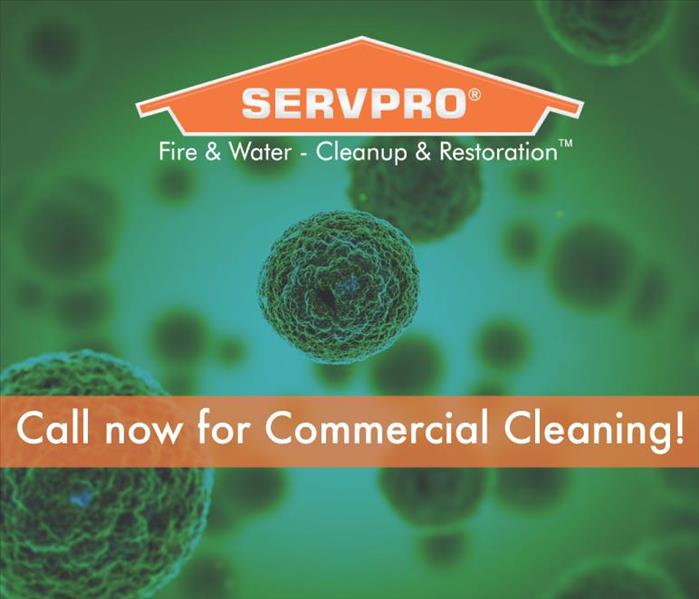 SERVPRO of East Central Cincinnati is here to help!
SERVPRO of East Central Cincinnati is here to help!
SERVPRO is Here to Help during this time of need
During this unprecedented time caused by the global pandemic of coronavirus, this is a reminder to our customers that we are specialists in cleaning services, and we adhere to the highest cleaning and sanitation standards.
Specialized Training
We are prepared to clean and disinfect your home or business, according to protocols set forth by the Centers for Disease Control and Prevention. We have years of experience in dealing with biological contaminants, and we will go beyond the scope of work that regular janitorial staff perform on a daily basis.
The CDC encourages cleaning of high-touch surfaces such as counters, tabletops, doorknobs, light switches, bathroom fixtures, toilets, phones, keyboards, tablets and tables. Other spaces mentioned in the CDC’s guidance for commercial spaces include:
- Kitchen/Food Areas
- Bathrooms
- Schools/Classrooms
- Offices
- Retail Spaces
- Water Fountains
- Shelving/Racks
- Sales Counters
- Carpets and Rugs
- Stair Handrails
- Elevator Cars
- Playground Equipment
- Fitness Equipment
Specialized Products
The CDC recommends usage of a labeled hospital-grade disinfectant with claims against similar pathogens to the coronavirus. Multiple products in the SERVPRO product line carry the EPA-approved emerging pathogens claims. While there is currently no product tested against this particular strain of the coronavirus, we are following all guidelines as provided by the CDC and local authorities.
Call Today for a Proactive Cleaning
If your home or business needs deep cleaning services, call the experts today – SERVPRO of East Central Cincinnati at (513) 561-7378!
4 Types of Mold You May See in Your Home
3/7/2020 (Permalink)
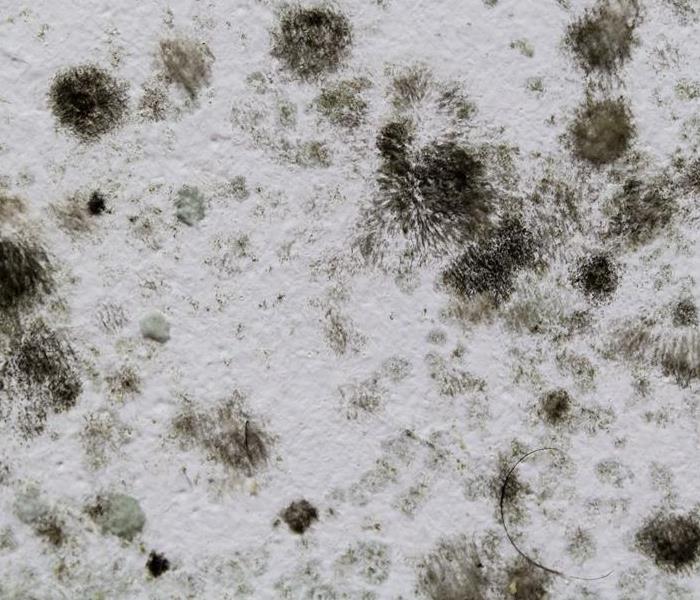 No matter the type of mold growth call your experts.
No matter the type of mold growth call your experts.
4 Types Of Molds
There are thousands of types of mold in the world, and many of them can find their way into your home. If you notice mold growth on your walls, floors or ceiling, you should call your local mold remediation company immediately. These certified professionals can identify the type of mold and use that information to formulate the best plan for getting rid of it.
1. Stachybotrys
More commonly known as black mold, this fungus is attracted to damp areas, particularly those that have water damage that has gone unnoticed or untreated for several weeks. You may notice black mold on walls or near air vents where condensation has collected. It may also infest cardboard, paper or wood.
2. Ulocladium
This type of mold is particularly attracted to areas that tend to have high humidity due to extensive and frequent water usage, such as kitchens and bathrooms. This mold growth may appear alone or beside other household molds.
3. Mucor
You are likely to see thick swatches of mucor near your HVAC unit. It thrives on the condensation that gathers around air conditioner coils and vents. Once it starts to grow, it can multiply very quickly. It is advisable to call mold specialists in Cincinnati, OH, as soon as you see these greyish white patches.
4. Chaetomium
This fungus often remains out of sight. It shows up in areas that have ongoing water damage. Attics and basements where leaks have occurred may start to take on a musty smell. This is a sign that you have a mold problem that needs to be mitigated.
No matter what type of mold growth you find in your home, the best course of action is to call in the experts. These technicians are trained to assess and strategize ways to overcome mold, and they have the skills to clean your home and restore it to its original condition.
Learning About Fire Extinguishers: 3 Steps for Protecting Your Business
3/7/2020 (Permalink)
 Being able to use an extinguisher with confidence can help your employees handle small fires at your business.
Being able to use an extinguisher with confidence can help your employees handle small fires at your business.
Fire Preparedness
Fire preparedness can be an important aspect of protecting your Indian Hill,OH, business from damage. While safety features such as a sprinkler system and posted evacuation procedures are useful, having a fire extinguisher in each room and knowing how to use it before a blaze breaks out can mean the difference between minor fire damage and having to make extensive repairs to your building.
1. Locate
If you rent office space, your landlord may provide you with extinguishers in areas where a blaze might break out, such as in a room with electronic equipment or in a breakroom that features a microwave or toaster oven. If you own the building, take time to learn what extinguisher sizes and types are appropriate. Water, dry chemical, multipurpose and CCO2 models are all available for public purchase.
2. Plan
When a fire breaks out, employees who do not know how to use a fire extinguisher may panic and try to employ other means to put out the blaze. However, this can have serious consequences. For example, if your restaurant’s cook tries to put out a grease-based kitchen fire with water, or strike it with a dish towel, the flames are likely to spread rather than be extinguished. Consider asking a fire damage and smoke cleanup company to help you with annual inspections and training tips to ensure all your employees are up to speed.
3. Practice
Being able to use an extinguisher with confidence can help your employees handle small fires at your business. Practice in a controlled area a few times a year and hold drills so that each of your employees knows how to handle the unit when a fire breaks out. Teach them to aim at the fire’s base and sweep the extinguisher back and forth until it is out.
Small fires can spread quickly and devastate your Indian Hill, OH, business. Knowing where to locate the nearest fire extinguisher, and how to use it, could help you snuff out a blaze before it can do any major damage.
The Advantages of Electronic Claims Services
1/21/2020 (Permalink)
 Electronic claims services make the process more transparent and comprehensive and faster
Electronic claims services make the process more transparent and comprehensive and faster
The Advantages of Electronic Claims Services
Insurance companies prefer to work with a professional disaster remediation team for many reasons. The right franchise offers many advantages, including the following:
- Trained and certified technicians
- A fast local response to a disaster
- An emphasis on restoring damaged items when possible and replacing when necessary
- An understanding of the best practices for restoration
- A proven process that makes quick work of an insurance claim
A SERVPRO franchise provides these benefits and many more, making them a favored choice for an emergency response for many insurance companies. Each vendor responds Faster to Any Size Disaster, arriving at an affected property in four hours or less.
Electronic Claims
The right remediation vendor in Mariemount, OH, provides a competitive advantage. The recovery process runs smoothly and restores a property in a timely manner while following IICRC standards, the industry leader in the inspection, cleaning and restoration of commercial properties. The hassle of an insurance claim is alleviated by a valued process that begins immediately. The inspection and damage assessment provided by SERVPRO technicians results in a First Notice of Loss document. Like all other documentation, it will be available electronically, which means it can be transmitted to all parties in no time. The same is true of photo documentation, which can often offer a clearer picture of itemized losses.
All of this makes it easier for the insurance agent to communicate with his or her client. Keeping in contact with the company that has suffered a loss, and providing concise documentation of losses and expenses, allows the insurance company to satisfy the client.
National Accounts
National managers for SERVPRO strive to keep the lines of communication open between the local mitigation franchise and the insurance company. The goal of this program is to ensure quality control, maintain oversight on all franchise workers, improve communication and assure completion of all paperwork for the insurance claim. The managers can speak with insurance companies and answer questions about the process. Electronic claims services make the process more transparent and comprehensive and faster.
4 Fire Prevention Tips that Keep Your Employees and Your Building Safe
12/29/2019 (Permalink)
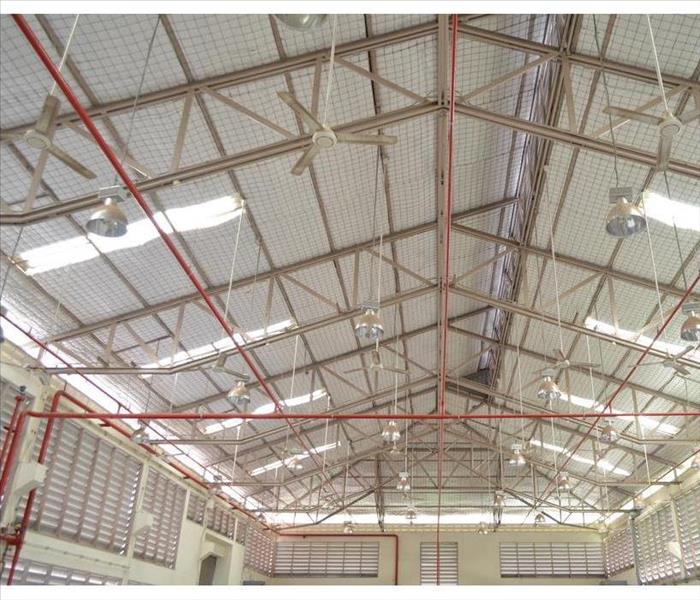 Sprinkler systems provide significant protection against possible fire damage
Sprinkler systems provide significant protection against possible fire damage
Did You Know That One of The Main Parts of Successful Fire Prevention is Preparation?
Despite its importance, it is easily overlooked in the busy day-to-day of business operations. Therefore, to ensure that you are doing everything you can to protect your property, enterprise and staff, you should try to implement the following four tips into your routine.
- Maintain communication
- Check for fire hazards
- Have fire suppression equipment
- Check expiration dates
Maintain Communication
A business fire is potentially hazardous, especially for companies that do not have a well constructed or communicated exit plan in place. It is vital to the safety of your employees and clients to have exit plans that are practiced and visible. If you are unsure of how to create and implement an evacuation strategy, then you can contact Indian Hill, OH, first responders or a fire restoration company. If you choose the latter, they will probably offer an assessment of your property to help you prepare such planning.
Check for Fire Hazards
Next, for the best fire prevention practices, you must eliminate as many fire hazards as possible. Therefore, maintain equipment, keep combustibles away from heat sources, check wiring and provide adequate space around appliances.
Have Fire Suppression Equipment
Fire suppression equipment, like extinguishers and sprinkler systems, provide significant protection against possible fire damage. Check your local fire codes to make sure that your business complies with all the appropriate safety measures for your industry.
Check Expiration Dates
Last, be sure to check the expiration dates on fire extinguishers. The typical shelf life on these safety products is between five and 15 years. It is also beneficial to perform routine drills to make sure that your alarm systems are working correctly.
Fire prevention is not a one-and-done type of thing. Safety requires diligence and practice. Therefore, perform routine inspections of your building to ensure that you are maintaining safe practices. Fires are dangerous and life-threatening, and sometimes good prevention practices can make all the difference.
Tips for Removing Mildew From Plants
11/28/2019 (Permalink)
 Taking great care of your garden can be a rewarding and fun experience
Taking great care of your garden can be a rewarding and fun experience
Tips for Removing and Preventing Mildew Growth on Plants
Whether you are a garden novice or an experienced green thumb, you may need a refresher when it comes to plant mildew. Mildew is a sub-group of molds that grows exclusively on live plants. It generally appears as a gray or white powder or splotches and can affect almost any part of your plants. It's usually found on leaves but it can also grow on fruit, flowers, and stems. Here are some tips for removing and preventing mildew growth on plants:
- Remove damaged plants
- Provide enough sunlight
- Keep the air well-circulated
- Clean your plants
- Contact a mold remediation expert
Grooming Your Garden
If you detect the mildew early enough, you can likely control it by removing damaged parts. Cut the affected leaves and dispose of them in the trash - do not compost them. Mildew can spread from the ground back to the same plant or onto other plants. Another important task is to thin out overcrowded areas. This gives all plants the best chance at health.
Maintaining Your Garden
In line with cutting back overgrowth and keeping your garden tidy, gardens requirement additional maintenance. Plants need good air circulation and plenty of sunlight. Plant mildew thrives in humid, wet climates. Exposure to breezes and ample sunlight reduces the chance of mildew growth. Additionally, create a habit of watering your plants at the base to avoid overwatering.
Saving Your Garden
Taking great care of your garden can be a rewarding and fun experience. Bringing sick plants back to health is invigorating. If you think that your garden is too far gone, however, you may need to contact a professional for assistance. They can help you identify the root of the problem and create a plan to keep your plants robust.
If your Deer Park, OH, oasis has developed plant mildew, do not despair. You will likely be able to rescue your greenery and prevent further mildew growth with some simple adjustments.
The Real Story of Mildew
9/19/2019 (Permalink)
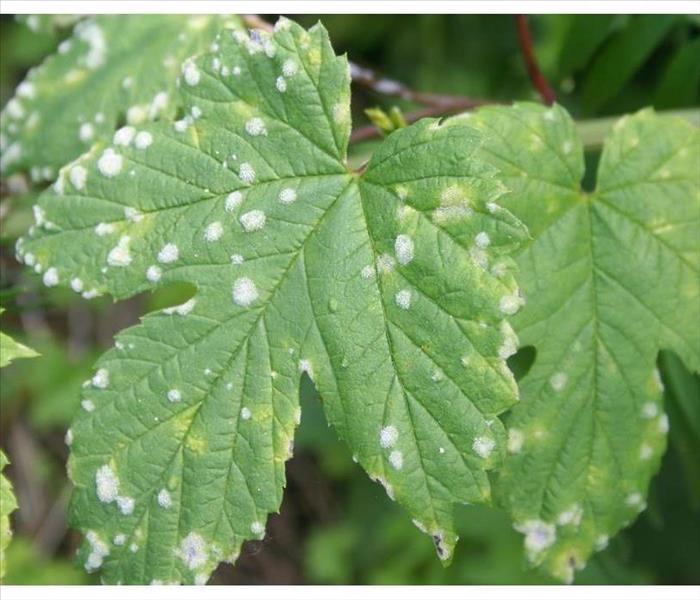 Plant mildew may indicate that something is wrong
Plant mildew may indicate that something is wrong
When you hear the word mildew, you probably pictures some type of growth in your bathroom. Little did you know, that is actually mold. Mildew is something entirely different. So, what can you do about mildew in Amberly Village, OH?
What is Mildew?
The short story is that mildew is a subgroup of mold that only grows on living plants. There are two species groups of mildew, each containing many subspecies. However, all mildew growth looks powdery and is usually white or light gray. The only way that it could ever be inside your house is if it was on one of your house plants; it won't spread to other surfaces. Some common plants to find mildew on are:
- Grains
- Grapes
- Onions
- Melons
- Lilacs
Where is Mildew?
Remember, mildew is only found on plants. If you hear someone talking about mildew in their bathroom or kitchen, they are not using the correct term. If you have hired a remediation specialist to remove mold from your home and they call it mildew, you should question their competency. Mildew is often plant specific, and a lot of species only grow on certain types of plants- for example, there is a type of plant mildew that will only grow on grape plants.
How To Eliminate Mildew
There are lots of products in stores that advertise "mildew removal". However, these products are mislabeled and are actually aimed at removing mold from tile, etc. Using these on your plants could kill them. Mildew usually only grows in certain conditions, so if you take these away the mildew should also go away. It likes humidity and low air circulation, so if your plants are crowded you should move them apart. Mildew is also more likely to be found on plants that are stressed or weak, so be sure research what your plant may be lacking if you find any powdery growth.
Finding plant mildew on your crops or houseplants isn't usually a death sentence for them, but a good indication that something is wrong. If you take steps to correct their living conditions, they'll be fine in no time!
3 Reasons To Connect With a Mitigation and Restoration Service for Your Business
3/25/2019 (Permalink)
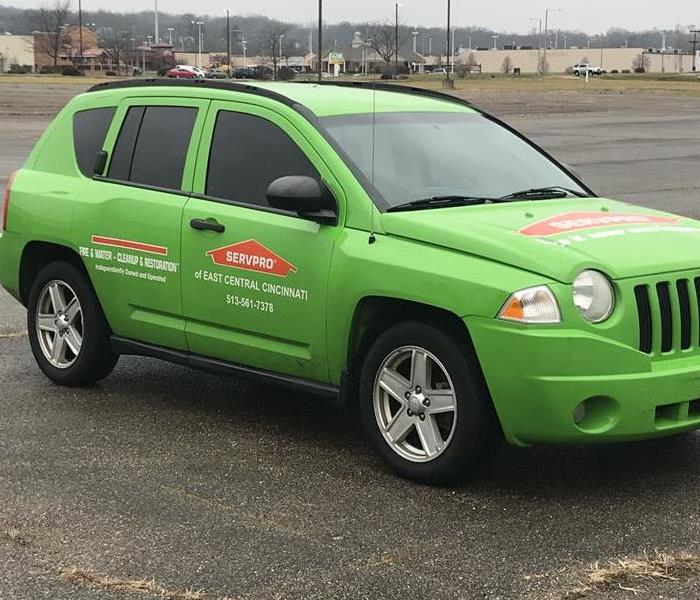 Connecting with a fire restoration service before tragedy strikes can give you peace of mind, no matter the nature of your business.
Connecting with a fire restoration service before tragedy strikes can give you peace of mind, no matter the nature of your business.
3 Reasons To Connect With A Mitigation And Restoration Service For Your Business
Your Cincinnati, OH business is likely a large investment for you in terms of both time and money. Commitment to growth, finding qualified employees and maintaining inventory are likely all important to you; however, when fire damages your building and its contents, this can pull focus away from these important tasks and leave you with the question of how to rebuild. Connecting with a fire restoration service before tragedy strikes can give you peace of mind, no matter the nature of your business.
1. Improved Risk Assessment
You may have some idea about what constitutes fire risk, but your building may contain hidden dangers that could increase the chance of a blaze. Reaching out to a mitigation service that responds to a variety of disasters, including fire, can help you uncover these issues with a professional inspection of your commercial property. Outdated electrical wiring, basement debris and the improper storage of flammable chemicals are only a few risks these inspections might uncover.
2. A Variety of Services Under One Roof
Facing a fire rebuild at your business can seem overwhelming, especially when paired with insurance matters and how to handle the financial losses you are likely to encounter during the repair process. Having a fire mitigation and restoration team on call can be of utmost assistance during this difficult time, as its professionals can advise you about which services you will need, from tear-outs to soot and smoke cleaning, so you can handle other aspects of the rebuild process without feeling overwhelmed.
3. Any Service, Large or Small
Having a fire restoration service number in your commercial contact list can help you resolve any fire emergency, no matter its size. Whether you had a small fire in your breakroom and need deodorizing solutions or rebuilding services after a major fire damaged the first floor of your building, you can turn to your contracted company day or night for assistance.
Owning a Cincinnati, OH business comes with many responsibilities. However, contracting a fire restoration service for on-call protection can provide you with peace of mind against the unknown.
Where Do You Find Mold?
3/8/2019 (Permalink)
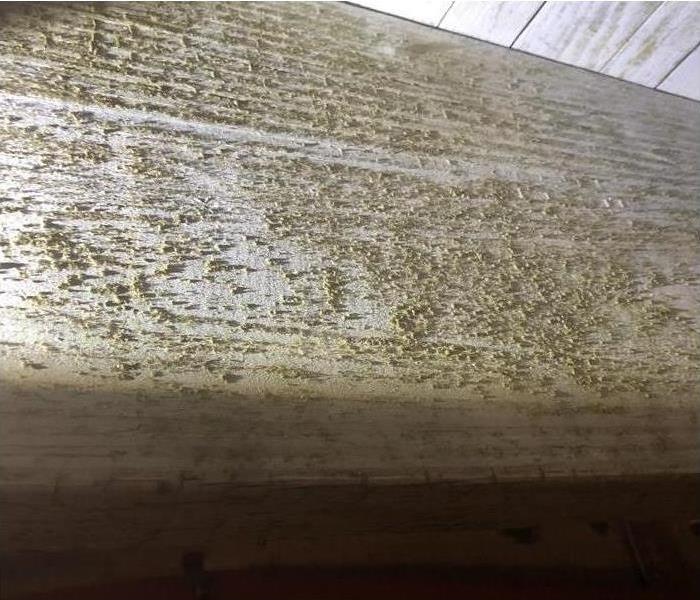 As the homeowner, you play a key role in avoiding mold damage.
As the homeowner, you play a key role in avoiding mold damage.
Where Do You Find Mold?
If you smell something musty in your home in Deer Park, OH you may have a mold problem. It may not be immediately visible, though. Mold damage can occur on almost any surface, particularly if it is porous. All it needs to thrive is moisture and something organic to feed on. Here are some places to look for mold and tips on how to keep these places fungus free.
Where Is It?
Mold or mildew growth may happen anywhere there is too much moisture. Common places in your home where mold could grow include:
- Drywall
- Carpet
- Furniture
- Insulation
- Draperies
Excess dust can also contribute to mold growth. A layer of dust on a surface gives spores in the air another place to attach and grow. Regular dusting can help keep fungus growth at bay.
How Is It Prevented?
Mold is everywhere. It gets inside your home by attaching to clothing, hair, pets and shoes. Once the spores are in this confined space, they start to look for a place to land and grow. Mold damage occurs when they find it.
The most effective way to prevent mold growth is by getting rid of the excess moisture in your home. Try to keep humidity levels between 40-50%. You can measure the humidity in your home with a device from your local hardware store. Make sure rooms that are prone to higher humidity, such as bathrooms and the kitchen, are properly ventilated for good air flow. When you notice a leak, call water remediation specialists immediately to dry and restore the area. Controlling moisture is vital to controlling the spread of mold.
As the homeowner, you play a key role in avoiding mold damage. Rid your home of excess moisture, and when you cannot, inspect all the surfaces where mold can grow to catch it at its beginning stages. By being vigilant about prevention, you can protect the air quality in your home.
Water Damage Claim: The Importance of Pretesting for Water Categories
2/19/2019 (Permalink)
 Providing information about the category and classification of the water and damage to your home.
Providing information about the category and classification of the water and damage to your home.
Water Damage Claim
Anyone who has experienced flooding is likely familiar with the various colors associated with floodwaters: white/clear, gray and black. These colors are often tied to a category and a classification which specifies the amount of safety precautions necessary and the level of mitigation and clean out. When filing a claim, it is critical to know the category and classification because each ascending level impacts the severity and costs of damage. Therefore, pretesting is used to designate the category and classification of water to ensure that claims and restorative preparations are efficient and accurate.
1. Category One
When filing an insurance claim, category one, or white/clear, water is the least expensive to remedy. The source is sanitary, meaning that there is no harmful bacteria or sewage present. While this category can be a relief, it is still necessary to act quickly to remove the water and repair the damage. If the water sits for too long, it can be contaminated by other items in the area, causing an elevation in category or classification.
2. Category Two
If the water is found to be category two, or gray water, through pretesting, then it is best that you do not go near it. This result indicates that there are organic and inorganic substances in the water and that you may become ill if it is consumed or touched.
3. Category Three
Category three, or black water, is the most dangerous water. The level of contamination includes sewage, chemicals, bacteria and possible toxins. It is likely that your insurance agent and company will recommend a disaster restoration specialist in the Madeira, OH, area who will probably seal the space as they work to remove the water safely.
Insurance claims require accurate representations of the damage to a property. Pretesting provides those assessments for insurers by providing definitive information about the category and classification of the water and damage to your home.
POST HOILDAY CLEANUP
12/11/2018 (Permalink)
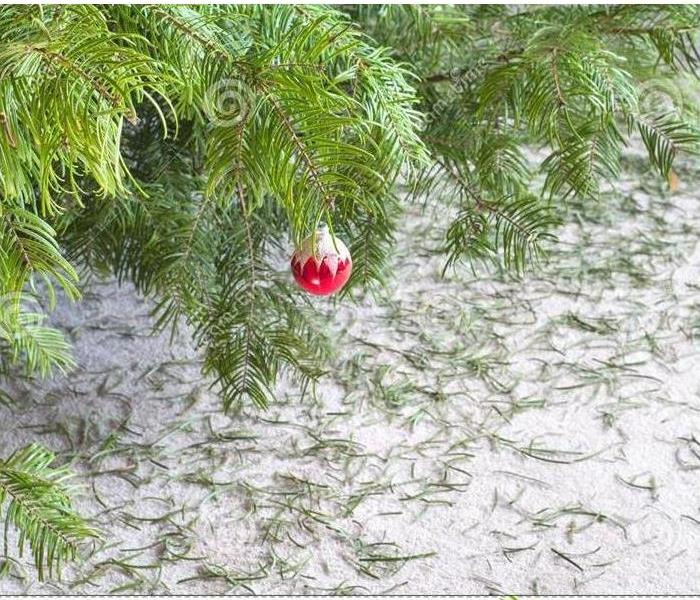 Pine needles and trees causing mold to be in your home.
Pine needles and trees causing mold to be in your home.
If you have stubborn tree needles sticking in the carpet or other seasonal messes? Call SERVPRO for help with all of your holiday cleanup needs...
Life is full of time consuming struggles during the holiday season that devour the precious moments you have to share with your loved ones let us at SERVPRO of East Central Cincinnati help with any choirs that steal these minutes away. We offer a wide variety of services from major remodeling to a simple house hold cleaning. Our staff is fully trained to execute the task at hand all while being compassionate when dealing with sensitive situations.
When you find yourself running around feeling like life is passing you by please don't wait until its too late call SERVPRO of East Central Cincinnati to rescue your time. Please spend your day's doing what's important to you and your family and as always remember the reason for the season.
WERE ALWAYS HERE TO HELP. 513-561-7378
What Can I Do Now to Prevent Future Mold?
11/27/2018 (Permalink)
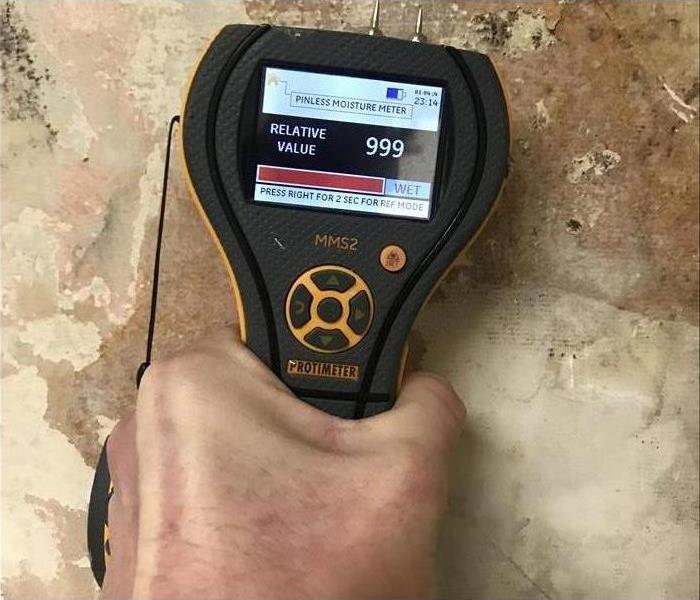 Moisture meter looking for mold in a Mariemount,OH business
Moisture meter looking for mold in a Mariemount,OH business
Mold - in recent years it has become a buzzword among home and business owners alike as its potential to damage property has become more understood. Fortunately, while mold can be difficult to eradicate once established from water damage or other means, there are steps you can take to prevent mold in your Mariemount, OH, business in the first place.
What Is Mold?
Mold is a type of fungi which thrives in damp spaces. There are good types but there are also types, such as black mold, which trigger allergies and discomfort. Mold spores are light and easily disperse through the air. They can grow on
- Carpets
- Drywall
- Pipes
- Ceilings
and many more places. Mold feeds on materials, gradually destroying the walls, attics and other areas where it settles. It’s important to take steps to prevent mold from happening in the first place.
Dry wet areas immediately
Mold relies on moisture, so keep your business dry as possible. Take care of leaky roofs or other areas that allow water to seep in and puddle. If you’ve experienced water damage, dispose of water-damaged carpets, furniture and other things that can’t be dried fully.
Monitor humidity indoors.
A humid environment is a mold-friendly environment. Experts suggest keeping indoor humidity between 30 and 60 percent. Invest in a moisture meter to detect high humidity caused by things like pipe condensation.
Improve ventilation
Whether you operate a kitchen or simply have a room used for washing equipment in your business, make sure it’s properly ventilated at all times. Venting appliances and equipment that produce moisture to the outside also ensures you don’t end up with water damage and mold growth.
Mold can be a hassle especially if you must invest in mold remediation services. Whether you’re trying to block new mold or prevent mold’s return, these mold prevention tips can help you keep your business free of this troublesome fungus.
Is It Possible to Flood Proof Your House?
11/18/2018 (Permalink)
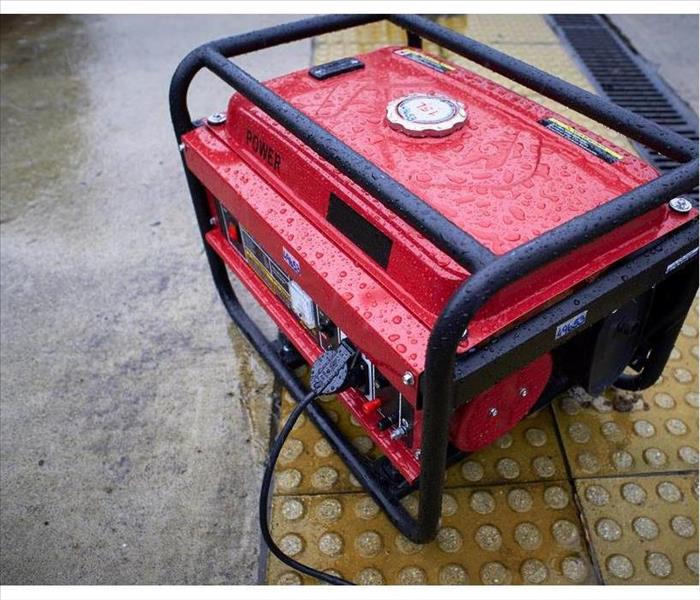 Make sure you have enough fuel in your Mariemount,OH generator
Make sure you have enough fuel in your Mariemount,OH generator
Take Flood Safety Measures
A flood may seem impossible to avoid, particularly if your home is located in a flood zone in Mariemount, OH. While you may not be able to make your residence flood proof, you should take flood safety measures. Here are several safety tips to keep in mind if you live in an area prone to flooding.
Elevate Critical Contents
Protect contents from water damage by lifting or moving items to a higher floor. This measure may also lower the risk of electrocution or other safety hazards in a flooded house. Try to elevate:
- Appliances
- Circuit breakers
- Electrical connections and wires
- Furniture
- Valuables
Factor in the anticipated level of flood waters when deciding whether to elevate items on cinder blocks, raised surfaces such as tables, or move contents to a higher floor of your home.
Gather Safety Supplies
If you plan to remain at home during a flood, you should have the following flood safety equipment:
- A first aid kit
- Enough food and water for at least several days
- A battery-powered radio
If you have a generator, make sure you have enough fuel. Operate this appliance outside to prevent carbon monoxide from building up inside your home.
Block Rising Water
Residents of regions prone to flooding may want to keep materials for sandbags on hand. These include
- Burlap bags
- Sand
- Shovels
- Plastic sheeting
You may also want to invest in a sandbag alternative. Be sure to factor in the predicted level of flood water to determine whether these materials will be an effective deterrent for flood water.
3 Common Causes of Basement Floods
6/21/2018 (Permalink)
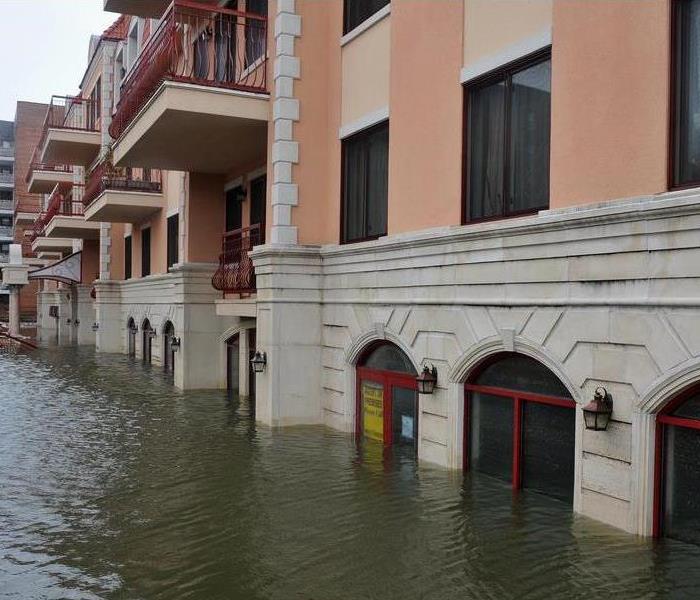 Basement flooding can cause serious problems for your Cincinnati, OH, home.
Basement flooding can cause serious problems for your Cincinnati, OH, home.
Finding water in your Cincinnati, OH, home’s basement can be surprising. However, this type of flooding might be more common than you think, especially during spring thaws or a long spell of wet weather. If this is the first time your basement has flooded, it may be due to one or more causes you can fix to prevent further damage to your home.
1. Cracks in the Walls and Floor
If you do not visit your basement often, you may fail to notice cracks in the walls and floors that can occur over many seasons of freezing and thawing. Once the cracks become wide enough, moisture may seep in at a rapid rate during a rainstorm and cause a basement flood. Ask the technicians from a water damage and cleanup service to check your basement once they drain away flood water and see what they can advise you about how to repair cracks.
2. Poor Drainage Around Your Home
If your home’s gutters and downspouts do not work properly, there is nowhere for the collected water to go except around the perimeter of your home. Keeping drainage systems working at peak performance can draw water away from your home and prevent it from seeping into your basement. Have your gutters and downspouts inspected and ask about whether pipe repair may improve drainage efficiency.
3. A Broken Sump Pump
The risk of basement flooding can increase significantly if your home’s sump pump is not working properly. You may want to have it checked before the thawing or rainy season, as finding a repairperson once this weather hits may be difficult. The longer water sits in your basement, the more contaminated it can become, so making sure your pump is working properly can save you hundreds of dollars in water damage repair.
Basement flooding can cause serious problems for your Cincinnati, OH, home. Knowing how water can enter the lowest level and how to prevent it may allow you to prevent this troubling issue. For more information, visit http://www.SERVPROeastcentralcincinnati.com//






 24/7 Emergency Service
24/7 Emergency Service





























